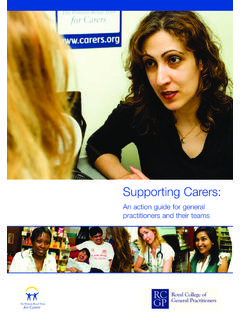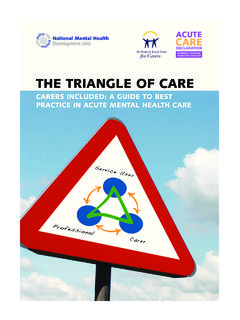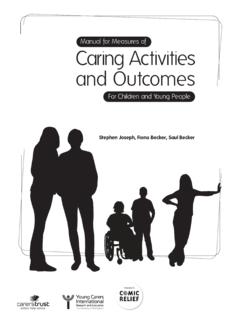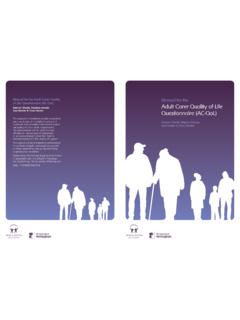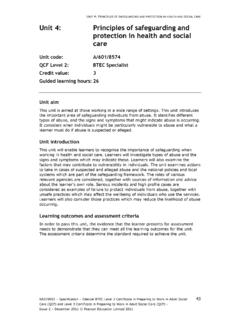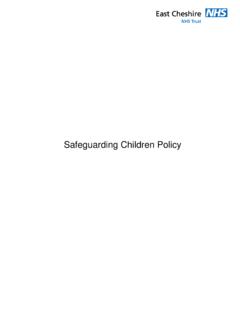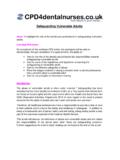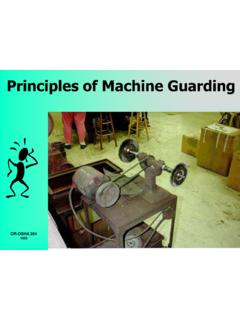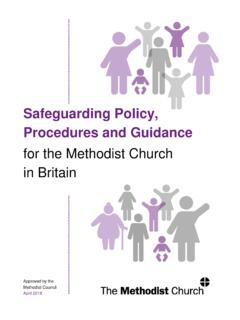Transcription of CARERS AND SAFEGUARDING ADULTS – …
1 CARERS AND SAFEGUARDING ADULTS . WORKING TOGETHER TO IMPROVE. OUTCOMES. It is hard to feel safe if we don't feel in control of what is happening in our life and hard to feel in control if we don't feel safe.. [ADASS Advice Note, April 2011]. 21 July 2011. ABOUT THIS PAPER. Status Professional practice, guidance, experience, skills and research are developing all the time. This short paper aims to promote discussion; evidence based practice and improved outcomes. It does not seek to amend or replace existing statutory guidance that may be in place. It reflects the content in the recently published ADASS Advice Note1. Focus The focus of this paper is on adult CARERS who give care and support to ADULTS . The paper does not seek to cover the position of young CARERS or adult CARERS of children with additional or other needs.
2 Its intended audiences are: Directors, Lead Members, Adult Social Care SAFEGUARDING and CARERS Leads, SAFEGUARDING ADULTS Partnerships, Health and Well-Being Partnerships and CARERS Organisations. Definition of Carer There is currently no single agreed definition of what is meant by the term carer . Within this paper we have used the definition contained within Commissioning for CARERS [2009]2. published by the Princess Royal Trust for CARERS and developed jointly with a number of organisations including ADASS: A carer spends a significant proportion of their time providing unpaid support to a family member, partner or friend who is ill, frail, disabled or has mental health or substance misuse problems. Adult at Risk ADASS has supported the Law Commission proposal to move away from the term vulnerable adult to adult at risk: anyone with social care needs who is or may be at risk of significant harm.
3 This definition is used in the recently published Pan London Procedures and is gaining increasing currency.[For full reference see below and end note 27]. Short Definition of Abuse The No Secrets definition of abuse, used by many SAFEGUARDING ADULTS ' partnerships, is currently subject to review. For the purpose of this paper abuse and neglect is defined as: a violation of an individual's human and civil rights by another person or persons which results in significant harm [No Secrets 2000]. Abuse is about the misuse of power and control that one person has over another. Where there is dependency, there is a possibility of abuse or neglect unless proportionate safeguards are put in place. Intent is not an issue at the point of deciding whether an act or failure to act on one or more occasions is abuse.
4 It is the impact of what is done or not done on the person and the harm or risk of significant harm to that individual that arises, at the time or over time, which matters. Social Care Institute for Excellence [SCIE] Protecting ADULTS at risk: London multi-agency policy and procedures to safeguard ADULTS from abuse, SCIE January 2011 Pan London Procedures 2011 . Adapted]. 2. CARERS AND SAFEGUARDING ADULTS . WORKING TOGETHER TO IMPROVE OUTCOMES. CONTENTS. Page FOREWORD 4. KEY MESSAGES 5. NATIONAL POLICY - SAFEGUARDING ADULTS 7. CARERS SPEAKING UP 8. CARERS AT RISK OF HARM 11. CARERS WHO HARM 13. MOVING FORWARD LOCALLY 16. APPENDICES. A SAFEGUARDING ADULTS The Policy Context 20. B Practical Approaches to SAFEGUARDING & Personalisation 23.
5 C Invitation to share practical experience 24. D Sources and References 26. 3. FOREWORD. This short review considers issues around CARERS and SAFEGUARDING ADULTS . This is done in the context of the underpinning principles 1 within the Vision for Adult Social Care, the priorities of the refreshed national strategy for CARERS : Recognised Valued and Supported3 and the 2011 Coalition Government statement of policy on adult safeguarding4. Safety, dignity and respect are important to everyone. We have long supported a rights based approach to issues of abuse and neglect and to the recognition and support of CARERS . These messages are included in our submissions in response to consultations on SAFEGUARDING adults5; the refresh of the national strategy for carers6; and in the 2011 ADASS SAFEGUARDING Advice Note7, which recognises: CARERS have a range of roles regarding SAFEGUARDING : as partners and informants.
6 Themselves as vulnerable to harm and abuse; as abusers.. We are clear that the vast majority of CARERS strive to act in the best interests of the person they support. There are times, however, when CARERS themselves experience abuse from the person to whom they are offering care and support or from the local community in which they live. Risk of harm to the supported person may also arise because of carer stress, tiredness, or lack of information, skills or support. Sadly, also, there are times where harm is intended. Sometimes, professionals may place undue confidence in the capacity of families to care effectively and safely. This is coming to be known as the rule of optimism 8. We need to keep it in mind.
7 This review paper looks at the evidence and practice around the three roles described above. The evidence base we have to inform current policy and practice is growing. We hope this paper will help local SAFEGUARDING ADULTS '. partnerships review local practice; encourage greater information and knowledge exchange; identify areas for learning and for empowerment: ensuring CARERS are recognised, listened to and respected by skilled and competent staff9 when concerns arise. We are grateful to all the people who have helped draft this paper. We trust this review will be seen as a timely and helpful resource and used as a contribution to local thinking and action by Directors, SAFEGUARDING ADULTS Boards and CARERS '.
8 Organisations. Dr. Adi Cooper Penny Furness-Smith Dr. Graeme Betts Co-Chair Co- Chair Chair, SAFEGUARDING SAFEGUARDING CARERS ' Policy Policy Network Policy Network Policy Network 1. See page 7 of this paper 4. KEY MESSAGES. The ADASS Advice Note10 of April 2011 recognises SAFEGUARDING is complex. Sometimes there are no perfect answers: there are usually risks as well as benefits associated with all decisions. Adult CARERS are not a homogenous group. Their needs and circumstances are very diverse. This paper explores issues around improving practice and securing desired outcomes for: CARERS speaking up about abuse or neglect within the community or within different care settings. CARERS who may experience intentional or unintentional harm from the person they are trying to support or from professionals and organisations they are in contact with.
9 CARERS who may unintentionally or intentionally harm or neglect the person they support. This is a signposting document and not a prescription. There are seven key messages we would like people to consider arising from this review. They are: LEADERSHIP SAFEGUARDING is everybody's business with Directors and local Boards listening, learning as well as leading on improved SAFEGUARDING outcomes and outcomes for CARERS . PARTNERSHIP SAFEGUARDING ADULTS Boards engage with CARERS and local stakeholders and work together for better SAFEGUARDING practice and outcomes for those involved in SAFEGUARDING processes. EMPOWERMENT - CARERS have access to information, advice and advocacy that is understandable and empowers them to share concerns and change harmful circumstances.
10 PREVENTION Community engagement, public and professional awareness is encouraged and accessible, and understandable information is available to CARERS that reduces risk of abuse. RECOGNITION & REPORTING Partnerships and practitioners understand the barriers to recognition and reporting and work in partnership to overcome them and ensure access to justice. PROTECTION & PROPORTIONALITY Responses have the person concerned at their centre and enable those at risk to inform outcomes linked to proportionate and protective services and supports. Risks are managed and harmful and abusive situations stopped. LEARNING & ACCOUNTABILITY Impacts are understood, practice monitored and SAFEGUARDING experiences and outcomes monitored to learn from the experiences of CARERS and people at risk of harm and those who seek to help them.
